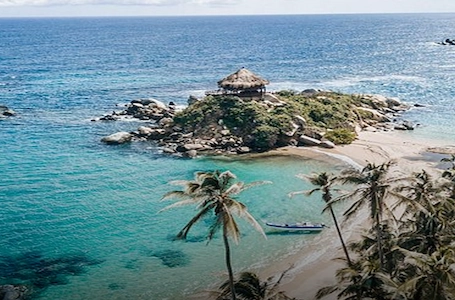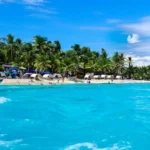Santa Marta, located on Colombia’s Caribbean coast, is the country’s oldest city and one of its most breathtaking destinations. Surrounded by the Sierra Nevada mountains and the turquoise waters of the Caribbean, this coastal city offers a perfect blend of history, culture, adventure, and relaxation. Whether you’re a beach lover, a history enthusiast, or an outdoor adventurer, Santa Marta has something for you.
A Brief History of Santa Marta
Founded in 1525 by Rodrigo de Bastidas, Santa Marta is the oldest surviving Spanish settlement in Colombia. It played a key role in Spanish colonization and is deeply connected to Simón Bolívar, the liberator of South America, who spent his final days at the Quinta de San Pedro Alejandrino. Today, Santa Marta is a gateway to some of Colombia’s most stunning landscapes and indigenous cultures.
Best Places to Visit in Santa Marta
1. Parque Tayrona: Colombia’s Most Beautiful National Park
One of Colombia’s top tourist destinations, Tayrona National Park is known for its:
- Paradise beaches with crystal-clear waters.
- Lush jungle hiking trails leading to breathtaking views.
- Wildlife spotting, including monkeys, exotic birds, and iguanas.
Must-visit beaches in Tayrona:
- Cabo San Juan – The most famous beach, featuring a scenic viewpoint.
- Playa Cristal – One of the most pristine and beautiful beaches.
- La Piscina – A calmer beach ideal for swimming and snorkeling.
Tip: The park has limited daily entries, so arrive early or book in advance.
2. Minca: A Mountain Paradise
Located 30 minutes from Santa Marta, Minca is a small town in the Sierra Nevada mountains, known for its:
- Coffee farms (like La Victoria and Finca La Candelaria).
- Waterfalls, such as Pozo Azul and Marinka Falls.
- Hiking and birdwatching in lush cloud forests.
3. Quinta de San Pedro Alejandrino
A must-visit historical site, this is the former home of Simón Bolívar, where he spent his final days in 1830. The estate features:
- Beautiful colonial architecture.
- A museum dedicated to Bolívar’s legacy.
- Sculptures and gardens perfect for a peaceful stroll.
4. Taganga: A Diving and Backpacker Hotspot
A small fishing village just 15 minutes from Santa Marta, Taganga is famous for:
- Affordable scuba diving (one of the cheapest places to get certified).
- Sunset views from the beach.
- Lively nightlife with beachfront bars.
Tip: While Taganga is popular, it has some safety concerns at night—stay in well-lit areas.
5. Playa Blanca & Rodadero
- Rodadero is a modern beach area near Santa Marta, perfect for families and resort stays.
- Playa Blanca, just a boat ride away, offers calmer waters and white sand, making it a great escape from the crowds.
6. Lost City Trek (Ciudad Perdida): A True Adventure
One of the most epic hikes in South America, the Lost City Trek is a 4 to 6-day jungle trek leading to an ancient Indigenous city older than Machu Picchu. Along the way, you’ll:
- Cross rivers and dense forests.
- Meet local Indigenous Kogi and Wiwa communities.
- Climb 1,200 stone steps to reach the mystical ruins.
Note: The trek requires good physical condition but is highly rewarding.
7. Ciénaga & the Magdalena Wetlands
For a cultural and off-the-beaten-path experience, visit Ciénaga, a coastal town with:
- Afro-Colombian culture and music.
- Mangrove boat tours through the wetlands.
- Beautiful colonial buildings and colorful street art.
Best Time to Visit Santa Marta
- December to April – The dry season, ideal for hiking and beaches.
- May to November – The rainy season, but fewer crowds and lush landscapes.
- February – Santa Marta’s Carnival, featuring parades and music.
Tip: Avoid holidays and weekends if you prefer a quieter experience.
What to Eat in Santa Marta
Santa Marta’s cuisine is influenced by Caribbean, Indigenous, and Spanish flavors. Some must-try dishes include:
- Arepas de huevo – Corn arepas stuffed with egg and deep-fried.
- Pargo frito con patacones – Fried red snapper with crispy plantains.
- Arroz con coco – Coconut rice, often served with seafood.
- Ceviche de camarón – Fresh shrimp ceviche with lime and spices.
- Bollo de yuca – A yucca-based dish, similar to a tamale.
For a drink, try Lulada (a tropical fruit juice) or Corozo juice (a local berry drink).
Where to Stay in Santa Marta
- Luxury: Hotel Boutique Don Pepe – A colonial-style boutique hotel in the city center.
- Mid-Range: Casa de Leda – A charming hotel with rooftop views.
- Budget: Masaya Hostel – A stylish and social hostel in La Candelaria.
- Eco-Lodges: Ecohabs Tayrona – Luxury bungalows inside Tayrona Park.
Best areas to stay:
- Centro Histórico – Ideal for exploring the city’s culture and history.
- El Rodadero – Great for beach lovers and families.
- Taganga – Best for diving and budget travelers.
- Minca – Perfect for nature lovers.
Nightlife in Santa Marta
Santa Marta offers a mix of relaxed beach bars and vibrant dance clubs. Some of the best nightlife spots include:
- La Brisa Loca – A rooftop bar with great cocktails and music.
- La Puerta – The best spot for dancing to salsa, reggaeton, and cumbia.
- Crab’s Bar – A rock and alternative music bar.
- Mirador 360 – A bar with panoramic views of the city.
Taganga also has a fun backpacker party scene, while Minca offers more chill bars in the jungle.
Final Tips for Visiting Santa Marta
- Pack for hot and humid weather – Light clothing, sunscreen, and a hat are essential.
- Be mindful of safety – Avoid walking alone at night in isolated areas.
- Bring cash – Many places in Tayrona and Minca don’t accept cards.
- Book Tayrona and Lost City tours in advance – These are popular attractions with limited availability.
- Respect Indigenous communities – When visiting sacred sites, follow local customs and ask permission before taking photos.
Conclusion
Santa Marta is a city where history, adventure, and nature come together in perfect harmony. Whether you’re relaxing on a Caribbean beach, hiking through the jungle, discovering ancient ruins, or exploring vibrant local culture, Santa Marta promises an unforgettable experience.




